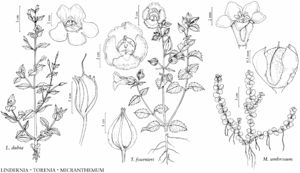Lindernia dubia
Monogr. Acad. Nat. Sci. Philadelphia 1: 141. 1935.
Annuals. Stems erect, ascending, or prostrate, not matted, usually rooting at proximal nodes, 1.5–27 (–38) cm. Leaves cauline, thin; petiole absent; blade spatulate, lanceolate, oblanceolate, elliptic, ovate, or obovate, (1–) 5–37 × (0.5–) 3–18 mm, palmately 3–5-veined or 1-nerved, not leathery, margins entire or remotely, sometimes coarsely, toothed; distal well developed or much reduced. Pedicels 0.5–31 mm, 1/2–5 times subtending leaves. Flowers chasmogamous or cleistogamous; chasmogamous: sepals 0.7–6.1 mm, connate to 1/8 lengths; corolla-tube and adaxial lip lavender or blue to white, abaxial lobes white with purple to blue markings, tube 2.5–8 mm, adaxial lip 1/2 abaxial; stamens 2; staminodes each with appendage and distal segment. Capsules ellipsoid, often obliquely, sometimes ovoid or subglobular, 1.4–6.3 (–7.5) × 1.2–3.3 mm. Seeds usually 6-angled, usually ribbed. 2n = 18.
Phenology: Flowering year-round.
Habitat: Wet ditches, meadows, borders of ponds, lakes, streams, moist to wet disturbed habitats.
Elevation: 0–2600 m.
Distribution
B.C., N.B., N.S., Ont., P.E.I., Que., Ala., Ariz., Ark., Calif., Colo., Conn., Del., D.C., Fla., Ga., Idaho, Ill., Ind., Iowa, Kans., Ky., La., Maine, Md., Mass., Mich., Minn., Miss., Mo., Nebr., Nev., N.H., N.J., N.Mex., N.Y., N.C., N.Dak., Ohio, Okla., Oreg., Pa., R.I., S.C., S.Dak., Tenn., Tex., Vt., Va., Wash., W.Va., Wis., Mexico, West Indies, Central America, South America, in Europe, Asia, Africa, Australia
Discussion
In Asia, Lindernia dubia is considered a noxious weed in rice paddies, where it has become resistant to some commonly used herbicides.
Lindernia dubia shows extreme morphological plasticity, especially in vegetative characters. This has led to the naming of species and varieties that have been accepted or not in recent treatments (for example, D. Q. Lewis 2000). B. A. Berger (2005) examined variation within the L. dubia complex and concluded that the recognition of these taxa is unwarranted.
Variety inundata, an estuarine form from the intertidal zone along the Atlantic Coast, continues to be recognized in several databases. However, W. R. Ferren Jr. and A. E. Schuyler (1980) described the clinal variation in these intertidal populations, ranging from typical Lindernia dubia to this form, with such variation sometimes evident on submerged and emergent parts of the same plant.
Selected References
None.
Lower Taxa
"thin" is not a number.
